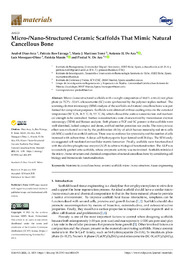Please use this identifier to cite or link to this item:
https://hdl.handle.net/11000/30740Full metadata record
| DC Field | Value | Language |
|---|---|---|
| dc.contributor.author | Díaz-Arca, Anabel | - |
| dc.contributor.author | Ros-Tárraga, Patricia | - |
| dc.contributor.author | Martínez Tomé, María J. | - |
| dc.contributor.author | de Aza, Antonio H. | - |
| dc.contributor.author | Meseguer-Olmo, Luis | - |
| dc.contributor.author | Patricia, Mazón Canales | - |
| dc.contributor.author | De Aza, Piedad | - |
| dc.contributor.other | Departamentos de la UMH::Agroquímica y Medio Ambiente | es_ES |
| dc.date.accessioned | 2024-01-26T10:49:05Z | - |
| dc.date.available | 2024-01-26T10:49:05Z | - |
| dc.date.created | 2021-03-12 | - |
| dc.identifier.citation | Materials 2021, 14, 1439 | es_ES |
| dc.identifier.issn | 1996-1944 | - |
| dc.identifier.uri | https://hdl.handle.net/11000/30740 | - |
| dc.description.abstract | Micro-/nano-structured scaffolds with a weight composition of 46.6% -tricalcium phosphate ( -TCP)—53.4% silicocarnotite (SC) were synthesized by the polymer replica method. The scanning electron microscopy (SEM) analysis of the scaffolds and natural cancellous bone was performed for comparison purposes. Scaffolds were obtained at three cooling rates via the eutectoid temperature (50 C/h, 16.5 C/h, 5.5 C/h), which allowed the surface nanostructure and mechanical strength to be controlled. Surface nanostructures were characterized by transmission electron microscopy (TEM) and Raman analysis. Both phases -TCP and SC present in the scaffolds were well-identified, looked compact and dense, and had neither porosities nor cracks. The non-cytotoxic effect was evaluated in vitro by the proliferation ability of adult human mesenchymal stem cells (ah-MSCs) seeded on scaffold surfaces. There was no evidence for cytotoxicity and the number of cells increased with culture time. A dense cell-hydroxyapatite layer formed until 28 days. The SEM analysis suggested cell-mediated extracellular matrix formation. Finally, scaffolds were functionalized with the alkaline phosphatase enzyme (ALP) to achieve biological functionalization. The ALP was successfully grafted onto scaffolds, whose enzymatic activity was maintained. Scaffolds mimicked the micro-/nano-structure and chemical composition of natural cancellous bone by considering cell biology and biomolecule functionalization. | es_ES |
| dc.format | application/pdf | es_ES |
| dc.format.extent | 17 | es_ES |
| dc.language.iso | eng | es_ES |
| dc.publisher | MDPI | es_ES |
| dc.rights | info:eu-repo/semantics/openAccess | es_ES |
| dc.rights | Attribution-NonCommercial-NoDerivatives 4.0 Internacional | * |
| dc.rights.uri | http://creativecommons.org/licenses/by-nc-nd/4.0/ | * |
| dc.subject | biomimetic | es_ES |
| dc.subject | cancellous bone | es_ES |
| dc.subject | ceramic scaffold | es_ES |
| dc.subject | micro-/nano-structure | es_ES |
| dc.subject | tissue engineering | es_ES |
| dc.subject.classification | Química Física | es_ES |
| dc.subject.other | CDU::5 - Ciencias puras y naturales::54 - Química | es_ES |
| dc.title | Micro-/Nano-Structured Ceramic Scaffolds That Mimic Natural Cancellous Bone | es_ES |
| dc.type | info:eu-repo/semantics/article | es_ES |
| dc.relation.publisherversion | https://doi.org/10.3390/ma14061439 | es_ES |

View/Open:
materials-14-01439.pdf
47,98 MB
Adobe PDF
Share:
.png)
